Teaching Assistant Report: Risk, Safety and Child Rights
VerifiedAdded on 2023/01/09
|10
|3551
|59
Report
AI Summary
This report focuses on the role of a teaching assistant, emphasizing the importance of creating a safe and secure learning environment. It begins with a risk assessment, identifying potential hazards in the classroom and during off-site activities, such as slips, trips, and the use of electronic devices. The report then delves into the rights of children, referencing the UNCRC and highlighting key articles related to non-discrimination, the best interests of the child, the right to life, and the right to be heard. It includes a reflection on the risk management process, utilizing Gibb's reflective cycle to analyze experiences and identify areas for improvement. The report also evaluates key policies and procedures related to incidents, accidents, illnesses, and emergencies, including COSHH assessments and school security measures. It highlights the importance of reporting and recording incidents, and examines the accountabilities and responsibilities associated with medication administration. The report concludes by emphasizing the need for continuous improvement in ensuring a safe and supportive environment for children.
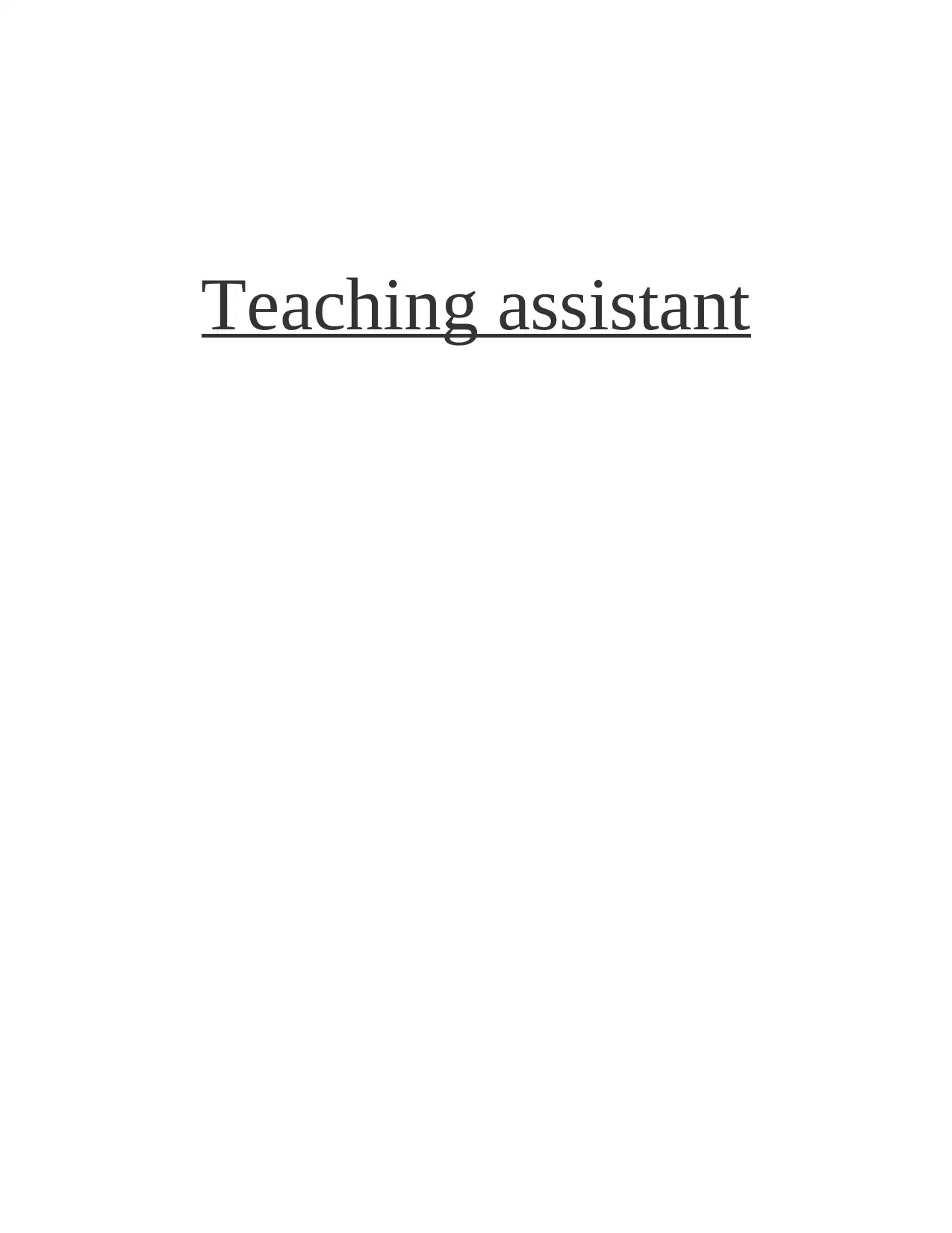
Teaching assistant
Paraphrase This Document
Need a fresh take? Get an instant paraphrase of this document with our AI Paraphraser
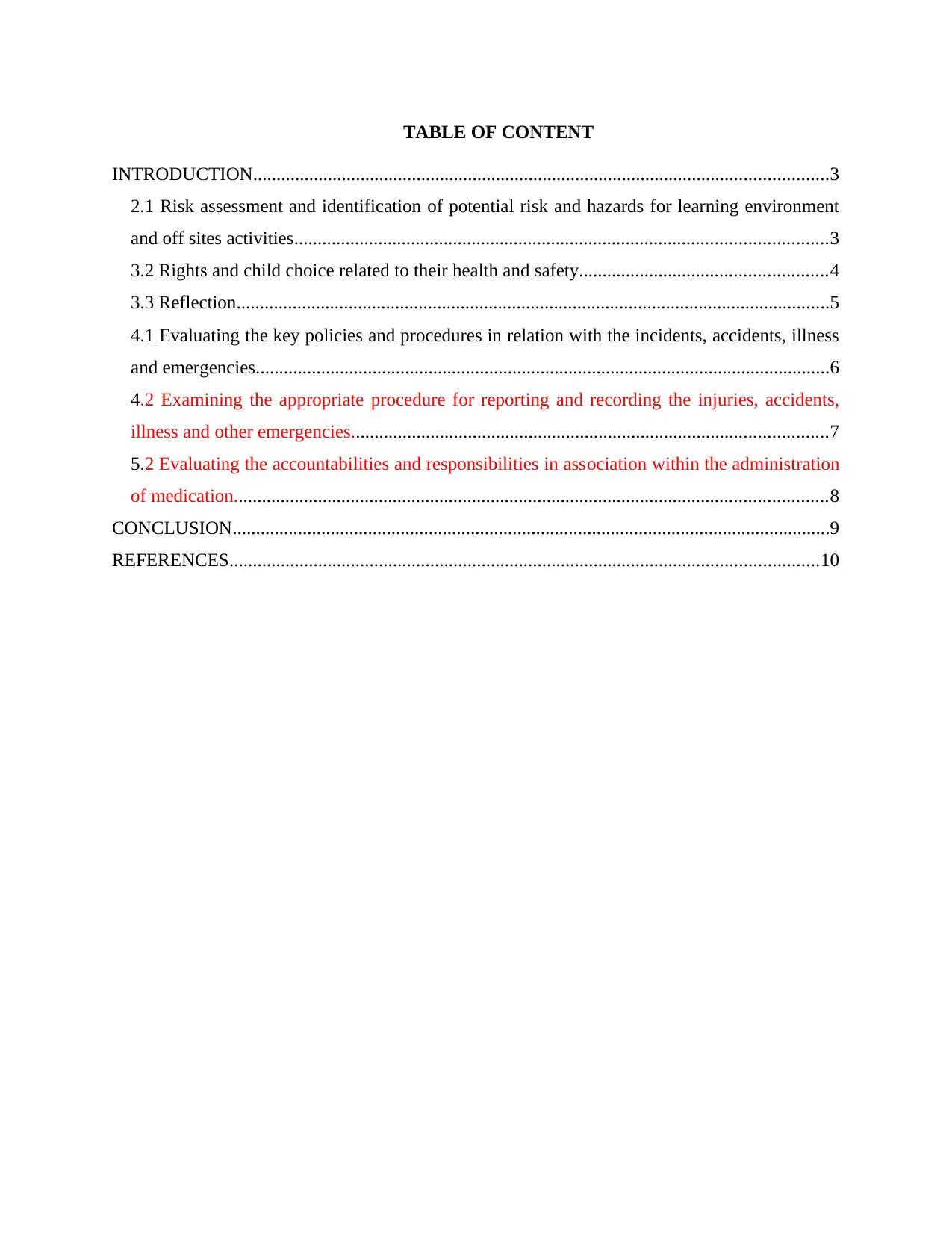
TABLE OF CONTENT
INTRODUCTION...........................................................................................................................3
2.1 Risk assessment and identification of potential risk and hazards for learning environment
and off sites activities..................................................................................................................3
3.2 Rights and child choice related to their health and safety.....................................................4
3.3 Reflection...............................................................................................................................5
4.1 Evaluating the key policies and procedures in relation with the incidents, accidents, illness
and emergencies...........................................................................................................................6
4.2 Examining the appropriate procedure for reporting and recording the injuries, accidents,
illness and other emergencies......................................................................................................7
5.2 Evaluating the accountabilities and responsibilities in association within the administration
of medication...............................................................................................................................8
CONCLUSION................................................................................................................................9
REFERENCES..............................................................................................................................10
INTRODUCTION...........................................................................................................................3
2.1 Risk assessment and identification of potential risk and hazards for learning environment
and off sites activities..................................................................................................................3
3.2 Rights and child choice related to their health and safety.....................................................4
3.3 Reflection...............................................................................................................................5
4.1 Evaluating the key policies and procedures in relation with the incidents, accidents, illness
and emergencies...........................................................................................................................6
4.2 Examining the appropriate procedure for reporting and recording the injuries, accidents,
illness and other emergencies......................................................................................................7
5.2 Evaluating the accountabilities and responsibilities in association within the administration
of medication...............................................................................................................................8
CONCLUSION................................................................................................................................9
REFERENCES..............................................................................................................................10
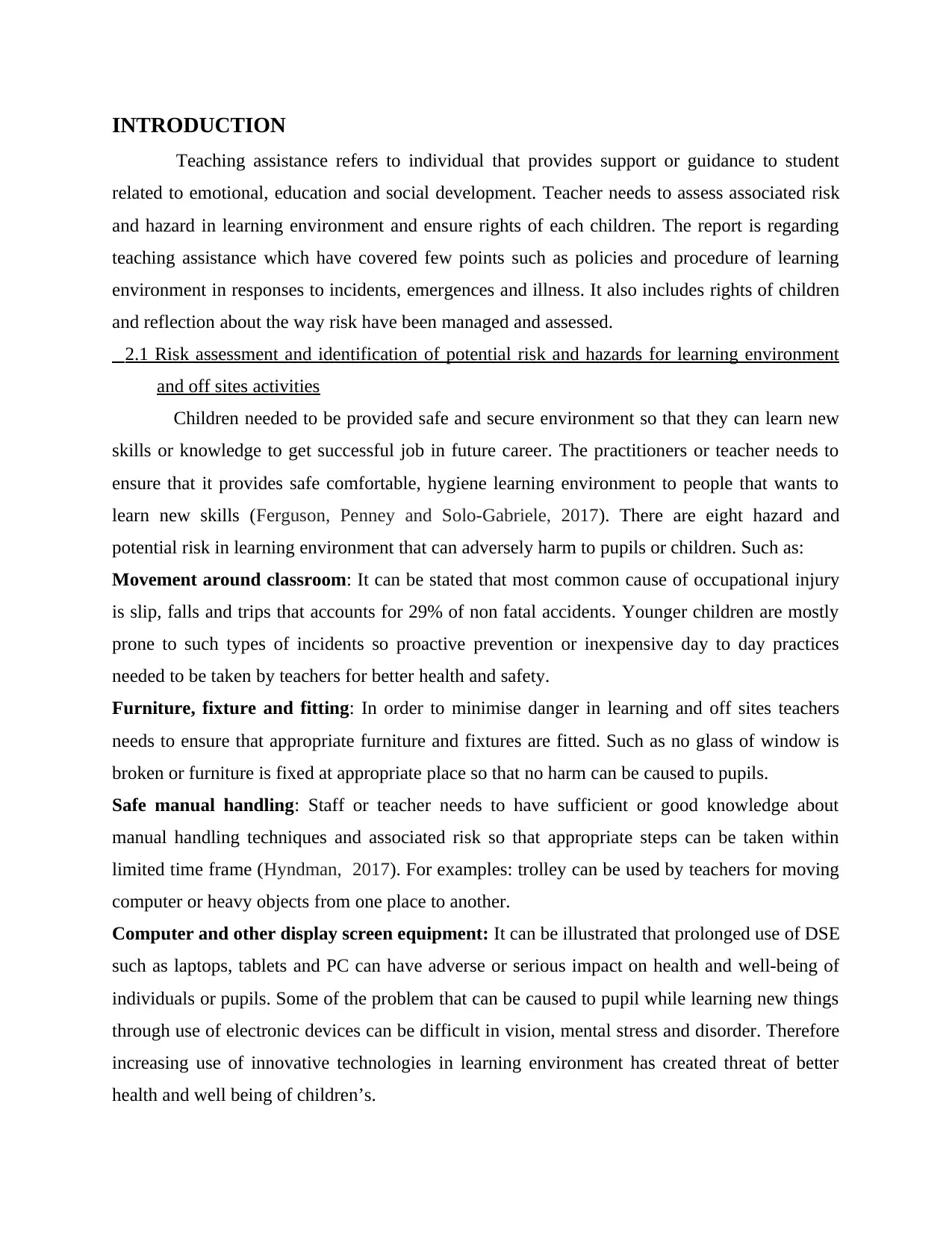
INTRODUCTION
Teaching assistance refers to individual that provides support or guidance to student
related to emotional, education and social development. Teacher needs to assess associated risk
and hazard in learning environment and ensure rights of each children. The report is regarding
teaching assistance which have covered few points such as policies and procedure of learning
environment in responses to incidents, emergences and illness. It also includes rights of children
and reflection about the way risk have been managed and assessed.
2.1 Risk assessment and identification of potential risk and hazards for learning environment
and off sites activities
Children needed to be provided safe and secure environment so that they can learn new
skills or knowledge to get successful job in future career. The practitioners or teacher needs to
ensure that it provides safe comfortable, hygiene learning environment to people that wants to
learn new skills (Ferguson, Penney and Solo-Gabriele, 2017). There are eight hazard and
potential risk in learning environment that can adversely harm to pupils or children. Such as:
Movement around classroom: It can be stated that most common cause of occupational injury
is slip, falls and trips that accounts for 29% of non fatal accidents. Younger children are mostly
prone to such types of incidents so proactive prevention or inexpensive day to day practices
needed to be taken by teachers for better health and safety.
Furniture, fixture and fitting: In order to minimise danger in learning and off sites teachers
needs to ensure that appropriate furniture and fixtures are fitted. Such as no glass of window is
broken or furniture is fixed at appropriate place so that no harm can be caused to pupils.
Safe manual handling: Staff or teacher needs to have sufficient or good knowledge about
manual handling techniques and associated risk so that appropriate steps can be taken within
limited time frame (Hyndman, 2017). For examples: trolley can be used by teachers for moving
computer or heavy objects from one place to another.
Computer and other display screen equipment: It can be illustrated that prolonged use of DSE
such as laptops, tablets and PC can have adverse or serious impact on health and well-being of
individuals or pupils. Some of the problem that can be caused to pupil while learning new things
through use of electronic devices can be difficult in vision, mental stress and disorder. Therefore
increasing use of innovative technologies in learning environment has created threat of better
health and well being of children’s.
Teaching assistance refers to individual that provides support or guidance to student
related to emotional, education and social development. Teacher needs to assess associated risk
and hazard in learning environment and ensure rights of each children. The report is regarding
teaching assistance which have covered few points such as policies and procedure of learning
environment in responses to incidents, emergences and illness. It also includes rights of children
and reflection about the way risk have been managed and assessed.
2.1 Risk assessment and identification of potential risk and hazards for learning environment
and off sites activities
Children needed to be provided safe and secure environment so that they can learn new
skills or knowledge to get successful job in future career. The practitioners or teacher needs to
ensure that it provides safe comfortable, hygiene learning environment to people that wants to
learn new skills (Ferguson, Penney and Solo-Gabriele, 2017). There are eight hazard and
potential risk in learning environment that can adversely harm to pupils or children. Such as:
Movement around classroom: It can be stated that most common cause of occupational injury
is slip, falls and trips that accounts for 29% of non fatal accidents. Younger children are mostly
prone to such types of incidents so proactive prevention or inexpensive day to day practices
needed to be taken by teachers for better health and safety.
Furniture, fixture and fitting: In order to minimise danger in learning and off sites teachers
needs to ensure that appropriate furniture and fixtures are fitted. Such as no glass of window is
broken or furniture is fixed at appropriate place so that no harm can be caused to pupils.
Safe manual handling: Staff or teacher needs to have sufficient or good knowledge about
manual handling techniques and associated risk so that appropriate steps can be taken within
limited time frame (Hyndman, 2017). For examples: trolley can be used by teachers for moving
computer or heavy objects from one place to another.
Computer and other display screen equipment: It can be illustrated that prolonged use of DSE
such as laptops, tablets and PC can have adverse or serious impact on health and well-being of
individuals or pupils. Some of the problem that can be caused to pupil while learning new things
through use of electronic devices can be difficult in vision, mental stress and disorder. Therefore
increasing use of innovative technologies in learning environment has created threat of better
health and well being of children’s.
⊘ This is a preview!⊘
Do you want full access?
Subscribe today to unlock all pages.

Trusted by 1+ million students worldwide
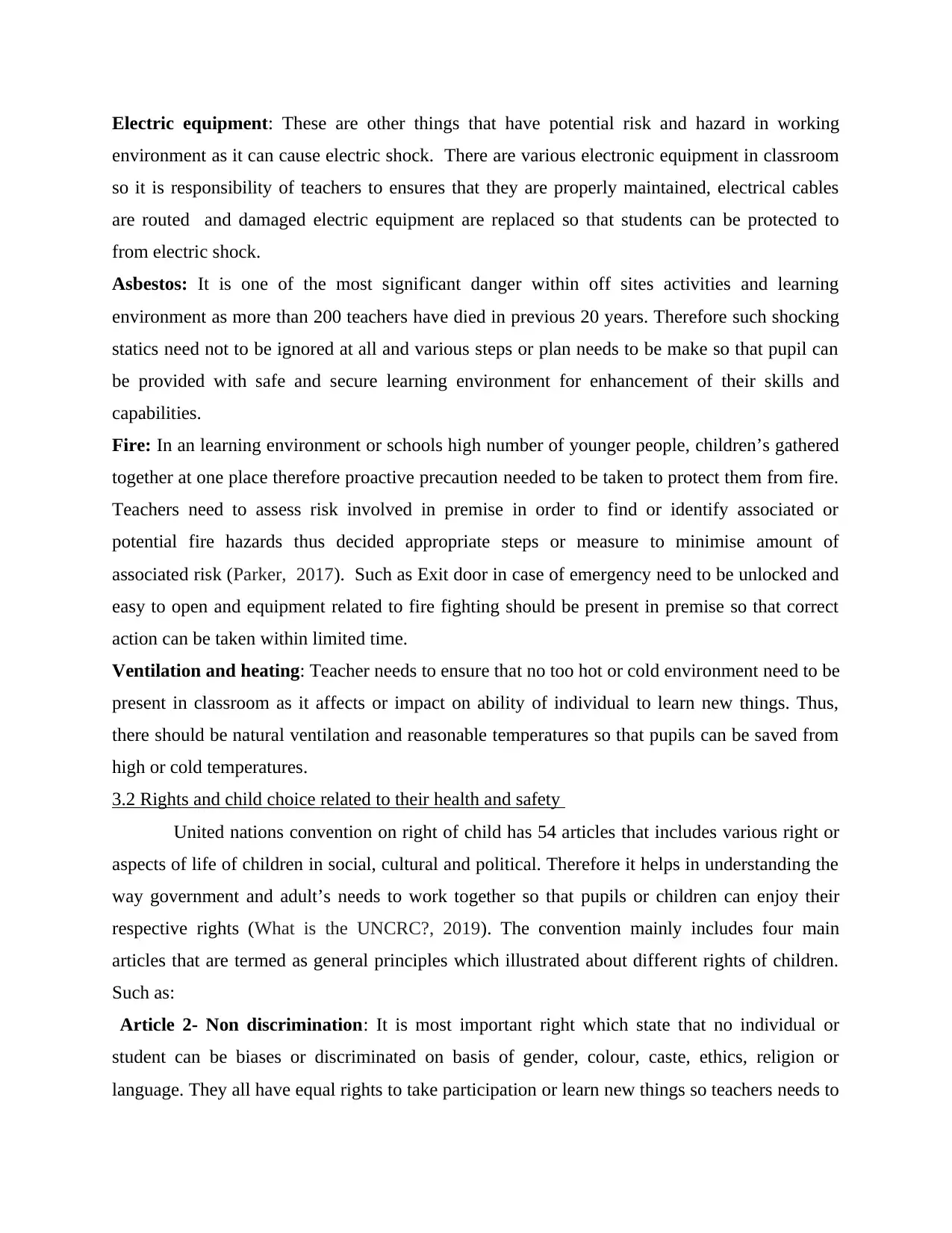
Electric equipment: These are other things that have potential risk and hazard in working
environment as it can cause electric shock. There are various electronic equipment in classroom
so it is responsibility of teachers to ensures that they are properly maintained, electrical cables
are routed and damaged electric equipment are replaced so that students can be protected to
from electric shock.
Asbestos: It is one of the most significant danger within off sites activities and learning
environment as more than 200 teachers have died in previous 20 years. Therefore such shocking
statics need not to be ignored at all and various steps or plan needs to be make so that pupil can
be provided with safe and secure learning environment for enhancement of their skills and
capabilities.
Fire: In an learning environment or schools high number of younger people, children’s gathered
together at one place therefore proactive precaution needed to be taken to protect them from fire.
Teachers need to assess risk involved in premise in order to find or identify associated or
potential fire hazards thus decided appropriate steps or measure to minimise amount of
associated risk (Parker, 2017). Such as Exit door in case of emergency need to be unlocked and
easy to open and equipment related to fire fighting should be present in premise so that correct
action can be taken within limited time.
Ventilation and heating: Teacher needs to ensure that no too hot or cold environment need to be
present in classroom as it affects or impact on ability of individual to learn new things. Thus,
there should be natural ventilation and reasonable temperatures so that pupils can be saved from
high or cold temperatures.
3.2 Rights and child choice related to their health and safety
United nations convention on right of child has 54 articles that includes various right or
aspects of life of children in social, cultural and political. Therefore it helps in understanding the
way government and adult’s needs to work together so that pupils or children can enjoy their
respective rights (What is the UNCRC?, 2019). The convention mainly includes four main
articles that are termed as general principles which illustrated about different rights of children.
Such as:
Article 2- Non discrimination: It is most important right which state that no individual or
student can be biases or discriminated on basis of gender, colour, caste, ethics, religion or
language. They all have equal rights to take participation or learn new things so teachers needs to
environment as it can cause electric shock. There are various electronic equipment in classroom
so it is responsibility of teachers to ensures that they are properly maintained, electrical cables
are routed and damaged electric equipment are replaced so that students can be protected to
from electric shock.
Asbestos: It is one of the most significant danger within off sites activities and learning
environment as more than 200 teachers have died in previous 20 years. Therefore such shocking
statics need not to be ignored at all and various steps or plan needs to be make so that pupil can
be provided with safe and secure learning environment for enhancement of their skills and
capabilities.
Fire: In an learning environment or schools high number of younger people, children’s gathered
together at one place therefore proactive precaution needed to be taken to protect them from fire.
Teachers need to assess risk involved in premise in order to find or identify associated or
potential fire hazards thus decided appropriate steps or measure to minimise amount of
associated risk (Parker, 2017). Such as Exit door in case of emergency need to be unlocked and
easy to open and equipment related to fire fighting should be present in premise so that correct
action can be taken within limited time.
Ventilation and heating: Teacher needs to ensure that no too hot or cold environment need to be
present in classroom as it affects or impact on ability of individual to learn new things. Thus,
there should be natural ventilation and reasonable temperatures so that pupils can be saved from
high or cold temperatures.
3.2 Rights and child choice related to their health and safety
United nations convention on right of child has 54 articles that includes various right or
aspects of life of children in social, cultural and political. Therefore it helps in understanding the
way government and adult’s needs to work together so that pupils or children can enjoy their
respective rights (What is the UNCRC?, 2019). The convention mainly includes four main
articles that are termed as general principles which illustrated about different rights of children.
Such as:
Article 2- Non discrimination: It is most important right which state that no individual or
student can be biases or discriminated on basis of gender, colour, caste, ethics, religion or
language. They all have equal rights to take participation or learn new things so teachers needs to
Paraphrase This Document
Need a fresh take? Get an instant paraphrase of this document with our AI Paraphraser
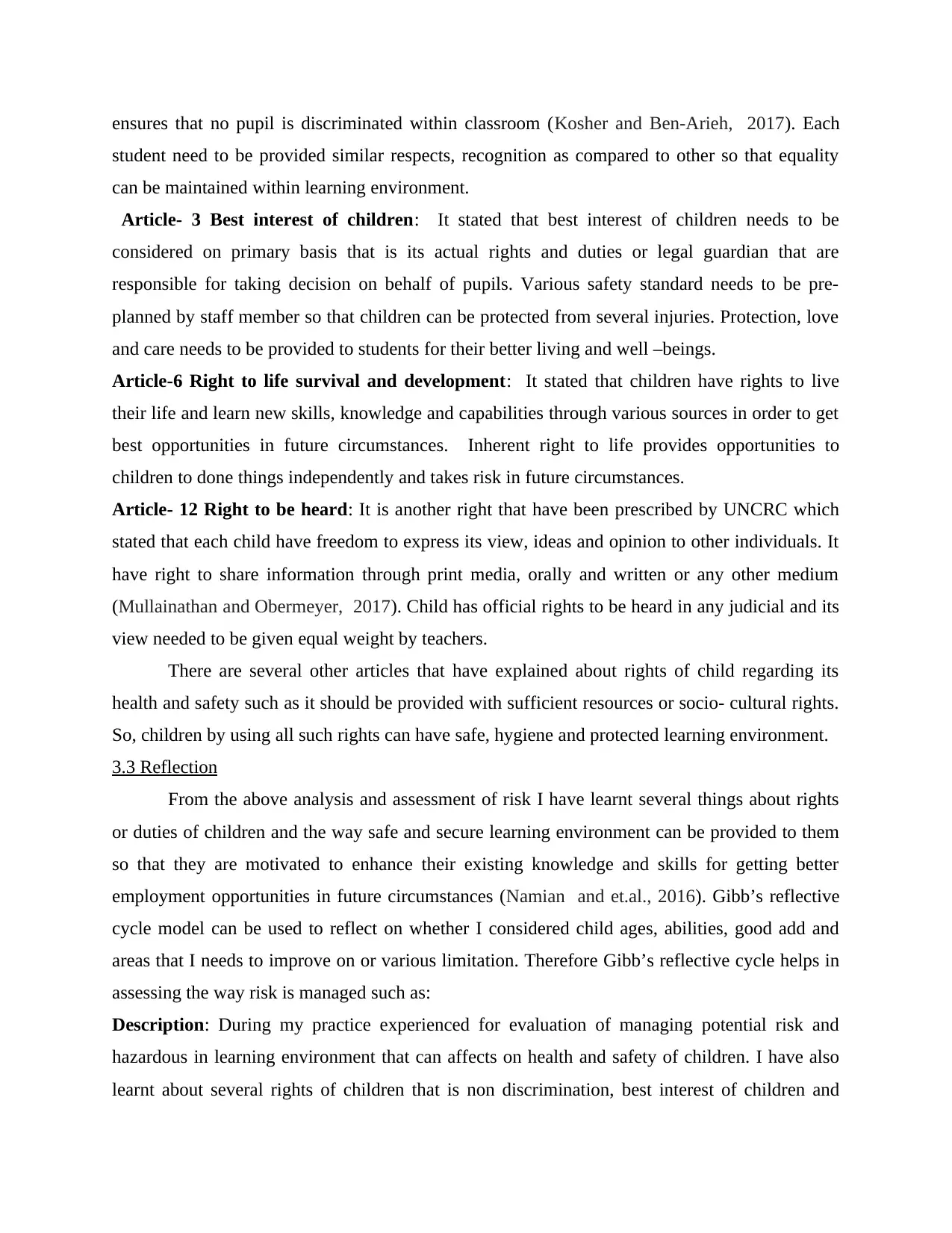
ensures that no pupil is discriminated within classroom (Kosher and Ben-Arieh, 2017). Each
student need to be provided similar respects, recognition as compared to other so that equality
can be maintained within learning environment.
Article- 3 Best interest of children: It stated that best interest of children needs to be
considered on primary basis that is its actual rights and duties or legal guardian that are
responsible for taking decision on behalf of pupils. Various safety standard needs to be pre-
planned by staff member so that children can be protected from several injuries. Protection, love
and care needs to be provided to students for their better living and well –beings.
Article-6 Right to life survival and development: It stated that children have rights to live
their life and learn new skills, knowledge and capabilities through various sources in order to get
best opportunities in future circumstances. Inherent right to life provides opportunities to
children to done things independently and takes risk in future circumstances.
Article- 12 Right to be heard: It is another right that have been prescribed by UNCRC which
stated that each child have freedom to express its view, ideas and opinion to other individuals. It
have right to share information through print media, orally and written or any other medium
(Mullainathan and Obermeyer, 2017). Child has official rights to be heard in any judicial and its
view needed to be given equal weight by teachers.
There are several other articles that have explained about rights of child regarding its
health and safety such as it should be provided with sufficient resources or socio- cultural rights.
So, children by using all such rights can have safe, hygiene and protected learning environment.
3.3 Reflection
From the above analysis and assessment of risk I have learnt several things about rights
or duties of children and the way safe and secure learning environment can be provided to them
so that they are motivated to enhance their existing knowledge and skills for getting better
employment opportunities in future circumstances (Namian and et.al., 2016). Gibb’s reflective
cycle model can be used to reflect on whether I considered child ages, abilities, good add and
areas that I needs to improve on or various limitation. Therefore Gibb’s reflective cycle helps in
assessing the way risk is managed such as:
Description: During my practice experienced for evaluation of managing potential risk and
hazardous in learning environment that can affects on health and safety of children. I have also
learnt about several rights of children that is non discrimination, best interest of children and
student need to be provided similar respects, recognition as compared to other so that equality
can be maintained within learning environment.
Article- 3 Best interest of children: It stated that best interest of children needs to be
considered on primary basis that is its actual rights and duties or legal guardian that are
responsible for taking decision on behalf of pupils. Various safety standard needs to be pre-
planned by staff member so that children can be protected from several injuries. Protection, love
and care needs to be provided to students for their better living and well –beings.
Article-6 Right to life survival and development: It stated that children have rights to live
their life and learn new skills, knowledge and capabilities through various sources in order to get
best opportunities in future circumstances. Inherent right to life provides opportunities to
children to done things independently and takes risk in future circumstances.
Article- 12 Right to be heard: It is another right that have been prescribed by UNCRC which
stated that each child have freedom to express its view, ideas and opinion to other individuals. It
have right to share information through print media, orally and written or any other medium
(Mullainathan and Obermeyer, 2017). Child has official rights to be heard in any judicial and its
view needed to be given equal weight by teachers.
There are several other articles that have explained about rights of child regarding its
health and safety such as it should be provided with sufficient resources or socio- cultural rights.
So, children by using all such rights can have safe, hygiene and protected learning environment.
3.3 Reflection
From the above analysis and assessment of risk I have learnt several things about rights
or duties of children and the way safe and secure learning environment can be provided to them
so that they are motivated to enhance their existing knowledge and skills for getting better
employment opportunities in future circumstances (Namian and et.al., 2016). Gibb’s reflective
cycle model can be used to reflect on whether I considered child ages, abilities, good add and
areas that I needs to improve on or various limitation. Therefore Gibb’s reflective cycle helps in
assessing the way risk is managed such as:
Description: During my practice experienced for evaluation of managing potential risk and
hazardous in learning environment that can affects on health and safety of children. I have also
learnt about several rights of children that is non discrimination, best interest of children and
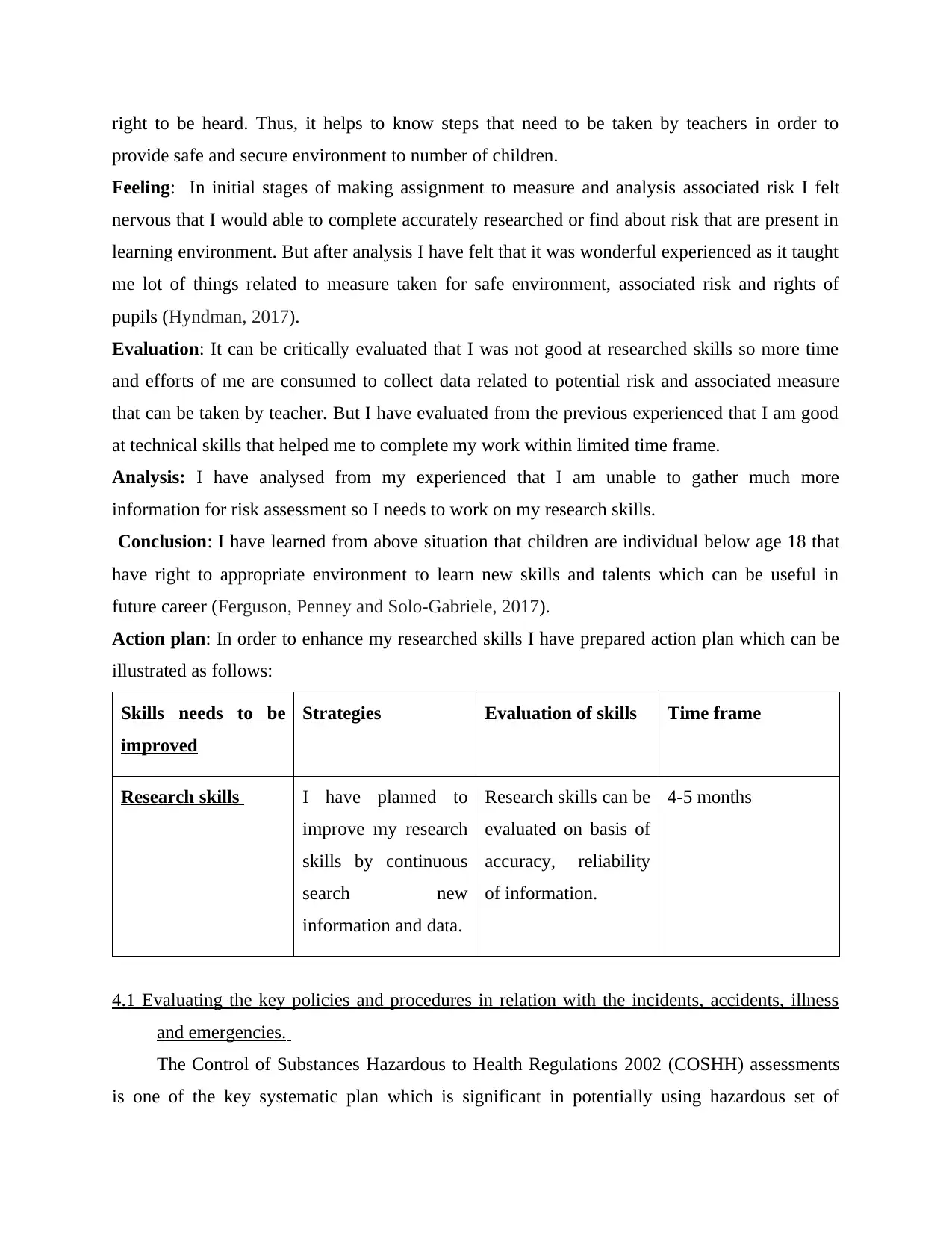
right to be heard. Thus, it helps to know steps that need to be taken by teachers in order to
provide safe and secure environment to number of children.
Feeling: In initial stages of making assignment to measure and analysis associated risk I felt
nervous that I would able to complete accurately researched or find about risk that are present in
learning environment. But after analysis I have felt that it was wonderful experienced as it taught
me lot of things related to measure taken for safe environment, associated risk and rights of
pupils (Hyndman, 2017).
Evaluation: It can be critically evaluated that I was not good at researched skills so more time
and efforts of me are consumed to collect data related to potential risk and associated measure
that can be taken by teacher. But I have evaluated from the previous experienced that I am good
at technical skills that helped me to complete my work within limited time frame.
Analysis: I have analysed from my experienced that I am unable to gather much more
information for risk assessment so I needs to work on my research skills.
Conclusion: I have learned from above situation that children are individual below age 18 that
have right to appropriate environment to learn new skills and talents which can be useful in
future career (Ferguson, Penney and Solo-Gabriele, 2017).
Action plan: In order to enhance my researched skills I have prepared action plan which can be
illustrated as follows:
Skills needs to be
improved
Strategies Evaluation of skills Time frame
Research skills I have planned to
improve my research
skills by continuous
search new
information and data.
Research skills can be
evaluated on basis of
accuracy, reliability
of information.
4-5 months
4.1 Evaluating the key policies and procedures in relation with the incidents, accidents, illness
and emergencies.
The Control of Substances Hazardous to Health Regulations 2002 (COSHH) assessments
is one of the key systematic plan which is significant in potentially using hazardous set of
provide safe and secure environment to number of children.
Feeling: In initial stages of making assignment to measure and analysis associated risk I felt
nervous that I would able to complete accurately researched or find about risk that are present in
learning environment. But after analysis I have felt that it was wonderful experienced as it taught
me lot of things related to measure taken for safe environment, associated risk and rights of
pupils (Hyndman, 2017).
Evaluation: It can be critically evaluated that I was not good at researched skills so more time
and efforts of me are consumed to collect data related to potential risk and associated measure
that can be taken by teacher. But I have evaluated from the previous experienced that I am good
at technical skills that helped me to complete my work within limited time frame.
Analysis: I have analysed from my experienced that I am unable to gather much more
information for risk assessment so I needs to work on my research skills.
Conclusion: I have learned from above situation that children are individual below age 18 that
have right to appropriate environment to learn new skills and talents which can be useful in
future career (Ferguson, Penney and Solo-Gabriele, 2017).
Action plan: In order to enhance my researched skills I have prepared action plan which can be
illustrated as follows:
Skills needs to be
improved
Strategies Evaluation of skills Time frame
Research skills I have planned to
improve my research
skills by continuous
search new
information and data.
Research skills can be
evaluated on basis of
accuracy, reliability
of information.
4-5 months
4.1 Evaluating the key policies and procedures in relation with the incidents, accidents, illness
and emergencies.
The Control of Substances Hazardous to Health Regulations 2002 (COSHH) assessments
is one of the key systematic plan which is significant in potentially using hazardous set of
⊘ This is a preview!⊘
Do you want full access?
Subscribe today to unlock all pages.

Trusted by 1+ million students worldwide
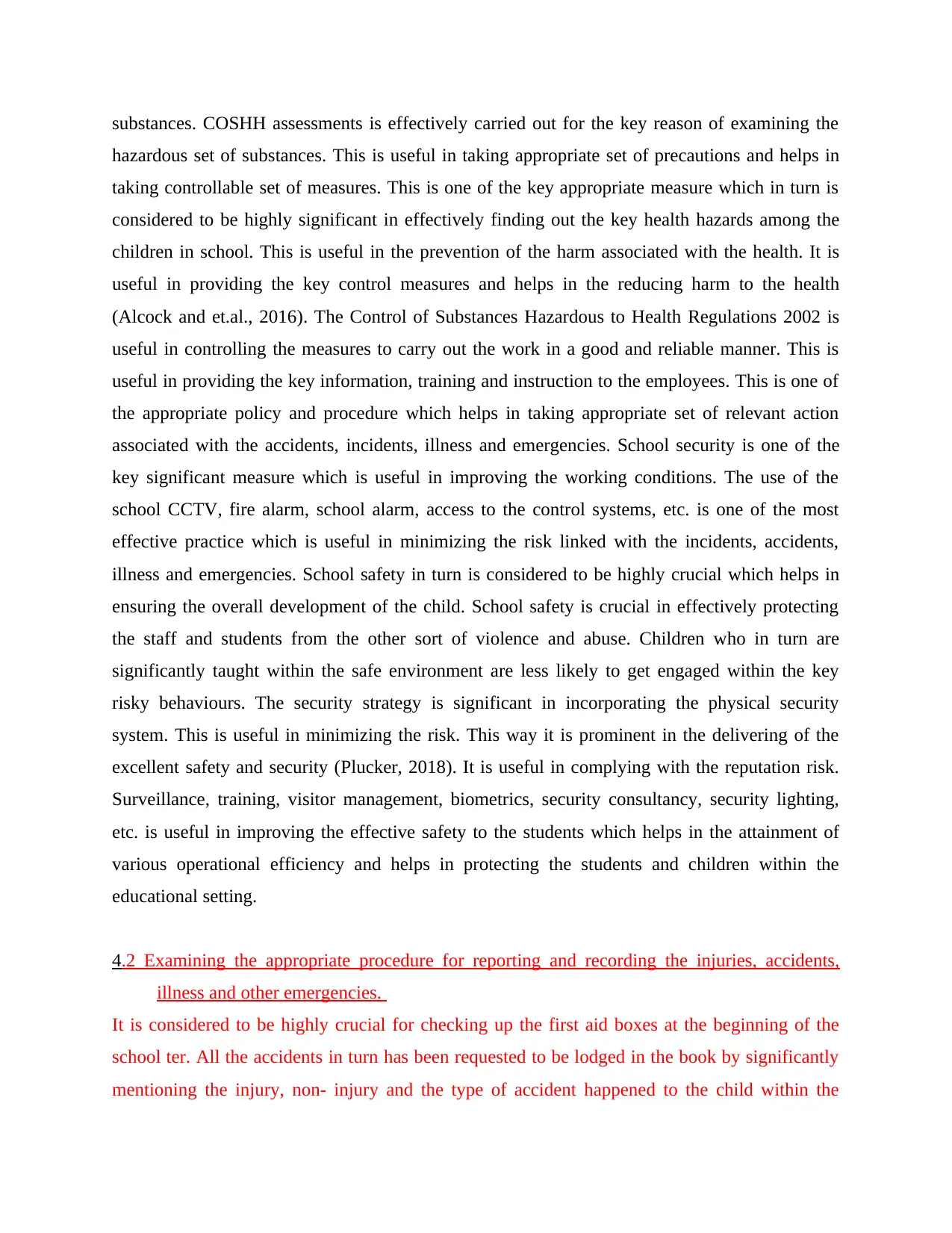
substances. COSHH assessments is effectively carried out for the key reason of examining the
hazardous set of substances. This is useful in taking appropriate set of precautions and helps in
taking controllable set of measures. This is one of the key appropriate measure which in turn is
considered to be highly significant in effectively finding out the key health hazards among the
children in school. This is useful in the prevention of the harm associated with the health. It is
useful in providing the key control measures and helps in the reducing harm to the health
(Alcock and et.al., 2016). The Control of Substances Hazardous to Health Regulations 2002 is
useful in controlling the measures to carry out the work in a good and reliable manner. This is
useful in providing the key information, training and instruction to the employees. This is one of
the appropriate policy and procedure which helps in taking appropriate set of relevant action
associated with the accidents, incidents, illness and emergencies. School security is one of the
key significant measure which is useful in improving the working conditions. The use of the
school CCTV, fire alarm, school alarm, access to the control systems, etc. is one of the most
effective practice which is useful in minimizing the risk linked with the incidents, accidents,
illness and emergencies. School safety in turn is considered to be highly crucial which helps in
ensuring the overall development of the child. School safety is crucial in effectively protecting
the staff and students from the other sort of violence and abuse. Children who in turn are
significantly taught within the safe environment are less likely to get engaged within the key
risky behaviours. The security strategy is significant in incorporating the physical security
system. This is useful in minimizing the risk. This way it is prominent in the delivering of the
excellent safety and security (Plucker, 2018). It is useful in complying with the reputation risk.
Surveillance, training, visitor management, biometrics, security consultancy, security lighting,
etc. is useful in improving the effective safety to the students which helps in the attainment of
various operational efficiency and helps in protecting the students and children within the
educational setting.
4.2 Examining the appropriate procedure for reporting and recording the injuries, accidents,
illness and other emergencies.
It is considered to be highly crucial for checking up the first aid boxes at the beginning of the
school ter. All the accidents in turn has been requested to be lodged in the book by significantly
mentioning the injury, non- injury and the type of accident happened to the child within the
hazardous set of substances. This is useful in taking appropriate set of precautions and helps in
taking controllable set of measures. This is one of the key appropriate measure which in turn is
considered to be highly significant in effectively finding out the key health hazards among the
children in school. This is useful in the prevention of the harm associated with the health. It is
useful in providing the key control measures and helps in the reducing harm to the health
(Alcock and et.al., 2016). The Control of Substances Hazardous to Health Regulations 2002 is
useful in controlling the measures to carry out the work in a good and reliable manner. This is
useful in providing the key information, training and instruction to the employees. This is one of
the appropriate policy and procedure which helps in taking appropriate set of relevant action
associated with the accidents, incidents, illness and emergencies. School security is one of the
key significant measure which is useful in improving the working conditions. The use of the
school CCTV, fire alarm, school alarm, access to the control systems, etc. is one of the most
effective practice which is useful in minimizing the risk linked with the incidents, accidents,
illness and emergencies. School safety in turn is considered to be highly crucial which helps in
ensuring the overall development of the child. School safety is crucial in effectively protecting
the staff and students from the other sort of violence and abuse. Children who in turn are
significantly taught within the safe environment are less likely to get engaged within the key
risky behaviours. The security strategy is significant in incorporating the physical security
system. This is useful in minimizing the risk. This way it is prominent in the delivering of the
excellent safety and security (Plucker, 2018). It is useful in complying with the reputation risk.
Surveillance, training, visitor management, biometrics, security consultancy, security lighting,
etc. is useful in improving the effective safety to the students which helps in the attainment of
various operational efficiency and helps in protecting the students and children within the
educational setting.
4.2 Examining the appropriate procedure for reporting and recording the injuries, accidents,
illness and other emergencies.
It is considered to be highly crucial for checking up the first aid boxes at the beginning of the
school ter. All the accidents in turn has been requested to be lodged in the book by significantly
mentioning the injury, non- injury and the type of accident happened to the child within the
Paraphrase This Document
Need a fresh take? Get an instant paraphrase of this document with our AI Paraphraser
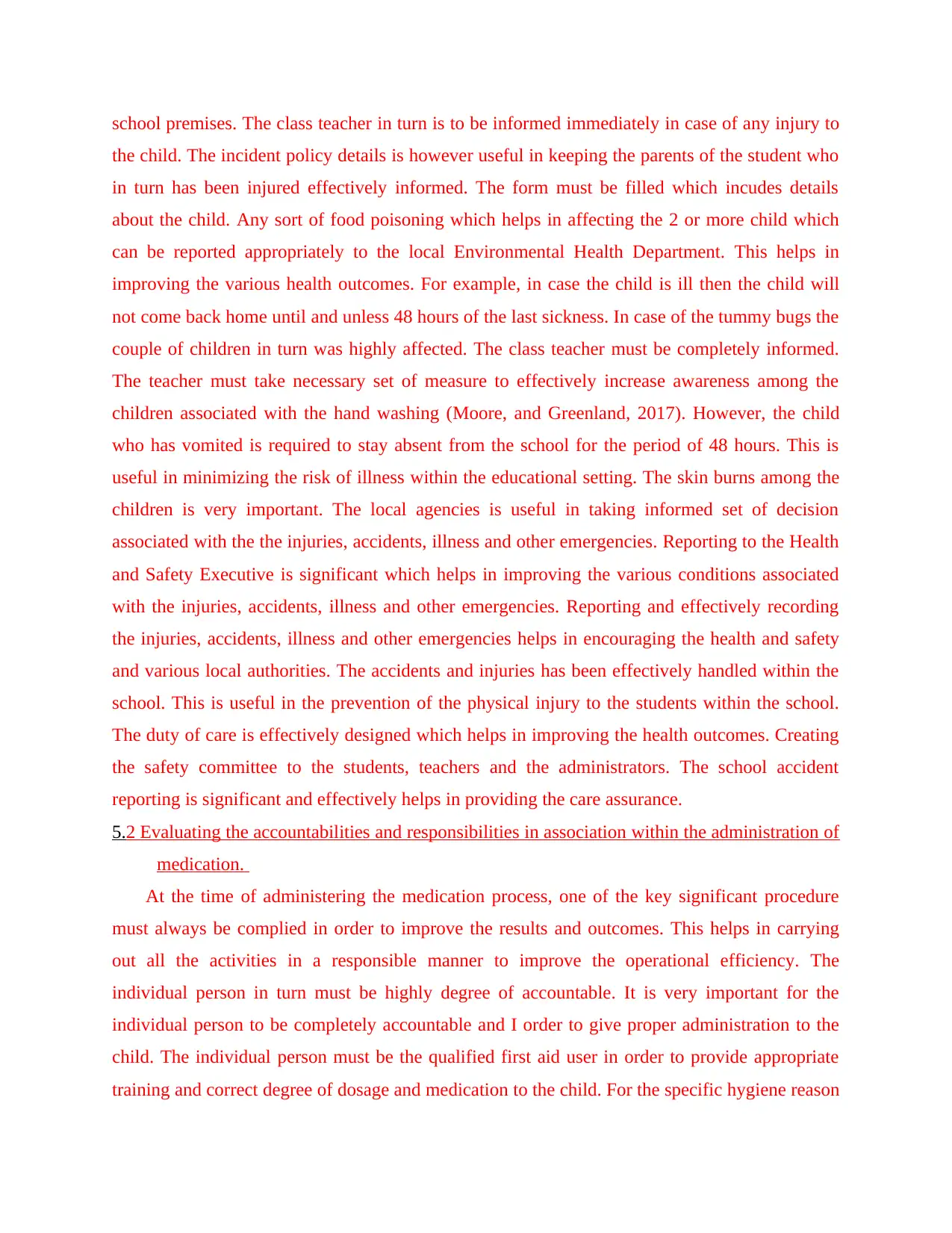
school premises. The class teacher in turn is to be informed immediately in case of any injury to
the child. The incident policy details is however useful in keeping the parents of the student who
in turn has been injured effectively informed. The form must be filled which incudes details
about the child. Any sort of food poisoning which helps in affecting the 2 or more child which
can be reported appropriately to the local Environmental Health Department. This helps in
improving the various health outcomes. For example, in case the child is ill then the child will
not come back home until and unless 48 hours of the last sickness. In case of the tummy bugs the
couple of children in turn was highly affected. The class teacher must be completely informed.
The teacher must take necessary set of measure to effectively increase awareness among the
children associated with the hand washing (Moore, and Greenland, 2017). However, the child
who has vomited is required to stay absent from the school for the period of 48 hours. This is
useful in minimizing the risk of illness within the educational setting. The skin burns among the
children is very important. The local agencies is useful in taking informed set of decision
associated with the the injuries, accidents, illness and other emergencies. Reporting to the Health
and Safety Executive is significant which helps in improving the various conditions associated
with the injuries, accidents, illness and other emergencies. Reporting and effectively recording
the injuries, accidents, illness and other emergencies helps in encouraging the health and safety
and various local authorities. The accidents and injuries has been effectively handled within the
school. This is useful in the prevention of the physical injury to the students within the school.
The duty of care is effectively designed which helps in improving the health outcomes. Creating
the safety committee to the students, teachers and the administrators. The school accident
reporting is significant and effectively helps in providing the care assurance.
5.2 Evaluating the accountabilities and responsibilities in association within the administration of
medication.
At the time of administering the medication process, one of the key significant procedure
must always be complied in order to improve the results and outcomes. This helps in carrying
out all the activities in a responsible manner to improve the operational efficiency. The
individual person in turn must be highly degree of accountable. It is very important for the
individual person to be completely accountable and I order to give proper administration to the
child. The individual person must be the qualified first aid user in order to provide appropriate
training and correct degree of dosage and medication to the child. For the specific hygiene reason
the child. The incident policy details is however useful in keeping the parents of the student who
in turn has been injured effectively informed. The form must be filled which incudes details
about the child. Any sort of food poisoning which helps in affecting the 2 or more child which
can be reported appropriately to the local Environmental Health Department. This helps in
improving the various health outcomes. For example, in case the child is ill then the child will
not come back home until and unless 48 hours of the last sickness. In case of the tummy bugs the
couple of children in turn was highly affected. The class teacher must be completely informed.
The teacher must take necessary set of measure to effectively increase awareness among the
children associated with the hand washing (Moore, and Greenland, 2017). However, the child
who has vomited is required to stay absent from the school for the period of 48 hours. This is
useful in minimizing the risk of illness within the educational setting. The skin burns among the
children is very important. The local agencies is useful in taking informed set of decision
associated with the the injuries, accidents, illness and other emergencies. Reporting to the Health
and Safety Executive is significant which helps in improving the various conditions associated
with the injuries, accidents, illness and other emergencies. Reporting and effectively recording
the injuries, accidents, illness and other emergencies helps in encouraging the health and safety
and various local authorities. The accidents and injuries has been effectively handled within the
school. This is useful in the prevention of the physical injury to the students within the school.
The duty of care is effectively designed which helps in improving the health outcomes. Creating
the safety committee to the students, teachers and the administrators. The school accident
reporting is significant and effectively helps in providing the care assurance.
5.2 Evaluating the accountabilities and responsibilities in association within the administration of
medication.
At the time of administering the medication process, one of the key significant procedure
must always be complied in order to improve the results and outcomes. This helps in carrying
out all the activities in a responsible manner to improve the operational efficiency. The
individual person in turn must be highly degree of accountable. It is very important for the
individual person to be completely accountable and I order to give proper administration to the
child. The individual person must be the qualified first aid user in order to provide appropriate
training and correct degree of dosage and medication to the child. For the specific hygiene reason
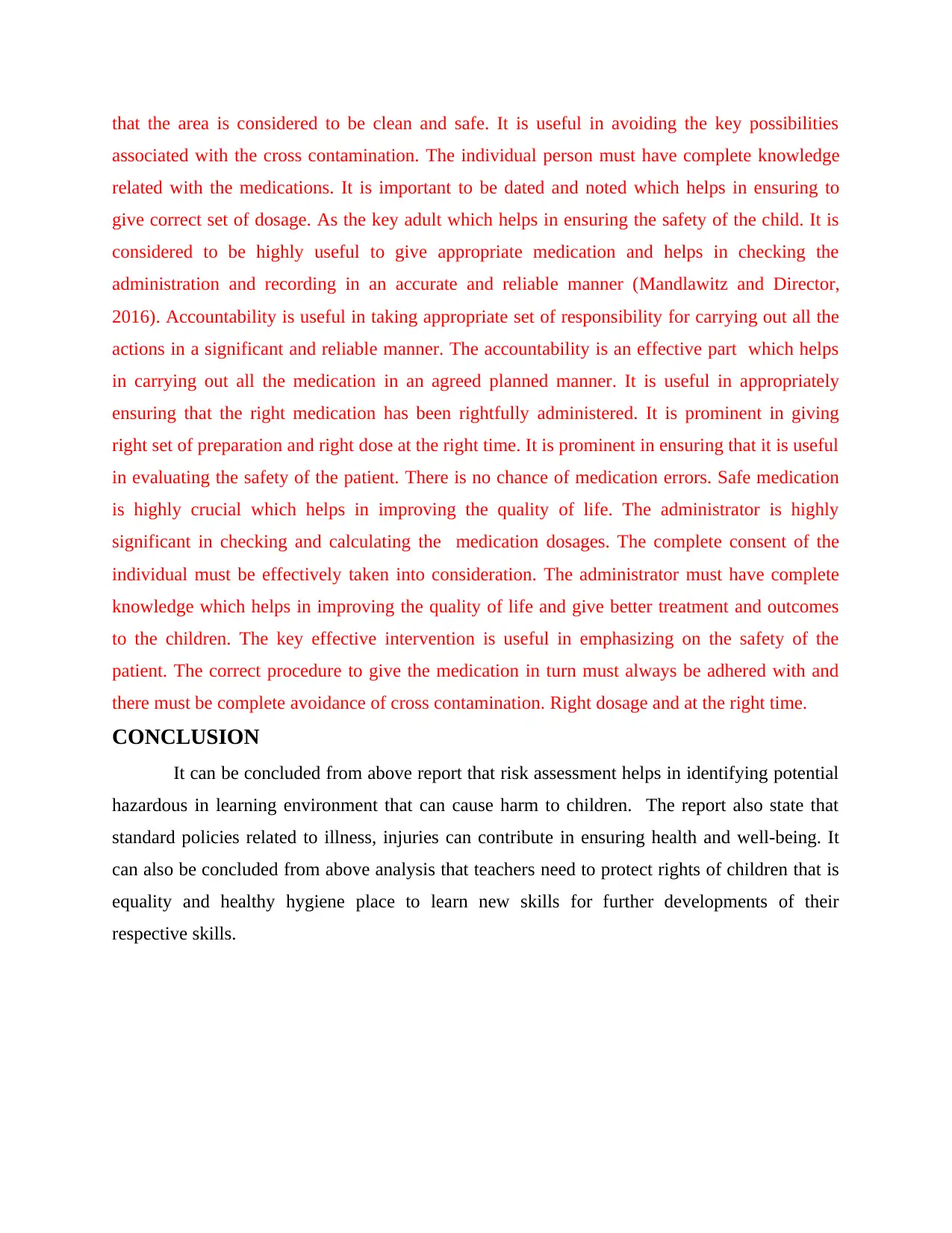
that the area is considered to be clean and safe. It is useful in avoiding the key possibilities
associated with the cross contamination. The individual person must have complete knowledge
related with the medications. It is important to be dated and noted which helps in ensuring to
give correct set of dosage. As the key adult which helps in ensuring the safety of the child. It is
considered to be highly useful to give appropriate medication and helps in checking the
administration and recording in an accurate and reliable manner (Mandlawitz and Director,
2016). Accountability is useful in taking appropriate set of responsibility for carrying out all the
actions in a significant and reliable manner. The accountability is an effective part which helps
in carrying out all the medication in an agreed planned manner. It is useful in appropriately
ensuring that the right medication has been rightfully administered. It is prominent in giving
right set of preparation and right dose at the right time. It is prominent in ensuring that it is useful
in evaluating the safety of the patient. There is no chance of medication errors. Safe medication
is highly crucial which helps in improving the quality of life. The administrator is highly
significant in checking and calculating the medication dosages. The complete consent of the
individual must be effectively taken into consideration. The administrator must have complete
knowledge which helps in improving the quality of life and give better treatment and outcomes
to the children. The key effective intervention is useful in emphasizing on the safety of the
patient. The correct procedure to give the medication in turn must always be adhered with and
there must be complete avoidance of cross contamination. Right dosage and at the right time.
CONCLUSION
It can be concluded from above report that risk assessment helps in identifying potential
hazardous in learning environment that can cause harm to children. The report also state that
standard policies related to illness, injuries can contribute in ensuring health and well-being. It
can also be concluded from above analysis that teachers need to protect rights of children that is
equality and healthy hygiene place to learn new skills for further developments of their
respective skills.
associated with the cross contamination. The individual person must have complete knowledge
related with the medications. It is important to be dated and noted which helps in ensuring to
give correct set of dosage. As the key adult which helps in ensuring the safety of the child. It is
considered to be highly useful to give appropriate medication and helps in checking the
administration and recording in an accurate and reliable manner (Mandlawitz and Director,
2016). Accountability is useful in taking appropriate set of responsibility for carrying out all the
actions in a significant and reliable manner. The accountability is an effective part which helps
in carrying out all the medication in an agreed planned manner. It is useful in appropriately
ensuring that the right medication has been rightfully administered. It is prominent in giving
right set of preparation and right dose at the right time. It is prominent in ensuring that it is useful
in evaluating the safety of the patient. There is no chance of medication errors. Safe medication
is highly crucial which helps in improving the quality of life. The administrator is highly
significant in checking and calculating the medication dosages. The complete consent of the
individual must be effectively taken into consideration. The administrator must have complete
knowledge which helps in improving the quality of life and give better treatment and outcomes
to the children. The key effective intervention is useful in emphasizing on the safety of the
patient. The correct procedure to give the medication in turn must always be adhered with and
there must be complete avoidance of cross contamination. Right dosage and at the right time.
CONCLUSION
It can be concluded from above report that risk assessment helps in identifying potential
hazardous in learning environment that can cause harm to children. The report also state that
standard policies related to illness, injuries can contribute in ensuring health and well-being. It
can also be concluded from above analysis that teachers need to protect rights of children that is
equality and healthy hygiene place to learn new skills for further developments of their
respective skills.
⊘ This is a preview!⊘
Do you want full access?
Subscribe today to unlock all pages.

Trusted by 1+ million students worldwide
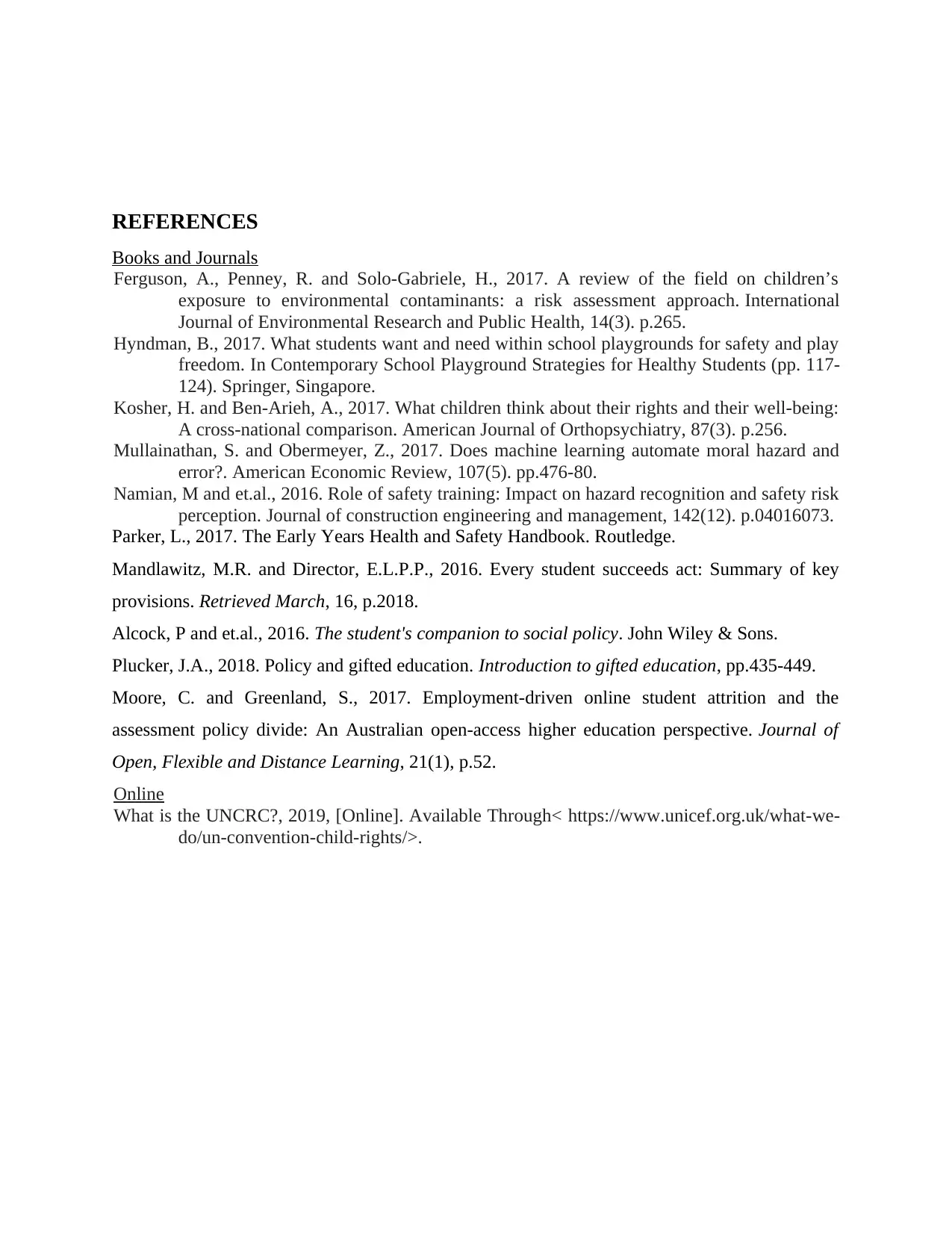
REFERENCES
Books and Journals
Ferguson, A., Penney, R. and Solo-Gabriele, H., 2017. A review of the field on children’s
exposure to environmental contaminants: a risk assessment approach. International
Journal of Environmental Research and Public Health, 14(3). p.265.
Hyndman, B., 2017. What students want and need within school playgrounds for safety and play
freedom. In Contemporary School Playground Strategies for Healthy Students (pp. 117-
124). Springer, Singapore.
Kosher, H. and Ben-Arieh, A., 2017. What children think about their rights and their well-being:
A cross-national comparison. American Journal of Orthopsychiatry, 87(3). p.256.
Mullainathan, S. and Obermeyer, Z., 2017. Does machine learning automate moral hazard and
error?. American Economic Review, 107(5). pp.476-80.
Namian, M and et.al., 2016. Role of safety training: Impact on hazard recognition and safety risk
perception. Journal of construction engineering and management, 142(12). p.04016073.
Parker, L., 2017. The Early Years Health and Safety Handbook. Routledge.
Mandlawitz, M.R. and Director, E.L.P.P., 2016. Every student succeeds act: Summary of key
provisions. Retrieved March, 16, p.2018.
Alcock, P and et.al., 2016. The student's companion to social policy. John Wiley & Sons.
Plucker, J.A., 2018. Policy and gifted education. Introduction to gifted education, pp.435-449.
Moore, C. and Greenland, S., 2017. Employment-driven online student attrition and the
assessment policy divide: An Australian open-access higher education perspective. Journal of
Open, Flexible and Distance Learning, 21(1), p.52.
Online
What is the UNCRC?, 2019, [Online]. Available Through< https://www.unicef.org.uk/what-we-
do/un-convention-child-rights/>.
Books and Journals
Ferguson, A., Penney, R. and Solo-Gabriele, H., 2017. A review of the field on children’s
exposure to environmental contaminants: a risk assessment approach. International
Journal of Environmental Research and Public Health, 14(3). p.265.
Hyndman, B., 2017. What students want and need within school playgrounds for safety and play
freedom. In Contemporary School Playground Strategies for Healthy Students (pp. 117-
124). Springer, Singapore.
Kosher, H. and Ben-Arieh, A., 2017. What children think about their rights and their well-being:
A cross-national comparison. American Journal of Orthopsychiatry, 87(3). p.256.
Mullainathan, S. and Obermeyer, Z., 2017. Does machine learning automate moral hazard and
error?. American Economic Review, 107(5). pp.476-80.
Namian, M and et.al., 2016. Role of safety training: Impact on hazard recognition and safety risk
perception. Journal of construction engineering and management, 142(12). p.04016073.
Parker, L., 2017. The Early Years Health and Safety Handbook. Routledge.
Mandlawitz, M.R. and Director, E.L.P.P., 2016. Every student succeeds act: Summary of key
provisions. Retrieved March, 16, p.2018.
Alcock, P and et.al., 2016. The student's companion to social policy. John Wiley & Sons.
Plucker, J.A., 2018. Policy and gifted education. Introduction to gifted education, pp.435-449.
Moore, C. and Greenland, S., 2017. Employment-driven online student attrition and the
assessment policy divide: An Australian open-access higher education perspective. Journal of
Open, Flexible and Distance Learning, 21(1), p.52.
Online
What is the UNCRC?, 2019, [Online]. Available Through< https://www.unicef.org.uk/what-we-
do/un-convention-child-rights/>.
1 out of 10
Related Documents
Your All-in-One AI-Powered Toolkit for Academic Success.
+13062052269
info@desklib.com
Available 24*7 on WhatsApp / Email
![[object Object]](/_next/static/media/star-bottom.7253800d.svg)
Unlock your academic potential
Copyright © 2020–2025 A2Z Services. All Rights Reserved. Developed and managed by ZUCOL.




